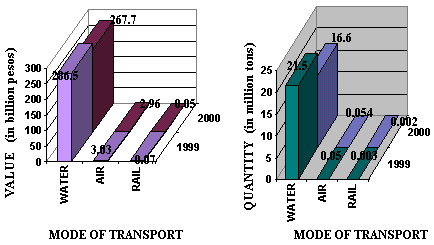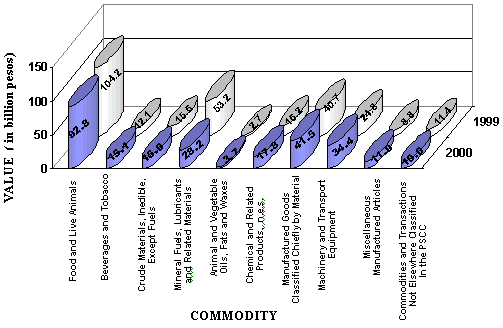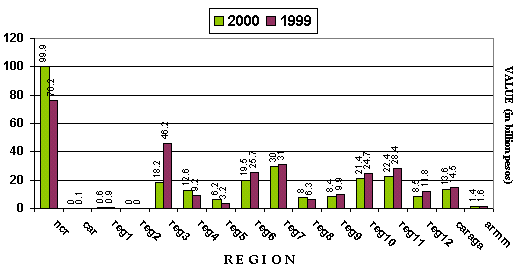Highlights of the 2023 Domestic Trade Statistics in the Philippines: Final Results
Value of domestic trade down at P270.75 billion
In the year 2000, total value of domestic trade decreased by 6.5 percent from P289.58 billion to P270.75 billion. Water transport remains the major mode of transport with 99.7 percent (16.63 million tons) share of the total quantity and 98.9 percent (P267.73 billion) share of the total value. Total quantity traded also declined by 22.6 percent from 21.56 million tons to 16.68 million tons. (See Figure 1)
Figure 1. Value and Quantity of Domestic Trade by Mode of Transport:
1999 and 2000
Food and live animals accounted for 34.3 percent
The bulk of the value of commodities that flowed throughout the country came from food and live animals with 34.3 percent, followed by manufactured goods classified chiefly by material (15.3 percent) and machinery and transport equipment (12.7 percent). Animal and vegetable oils, fats and waxes registered the least value of P3.68 billion (1.4 percent). (See Figure 2).
Figure 2. Value of Domestic Trade by Commodity Section: 1999 and 2000
NCR leads with P99.9 billion
Among the regions, NCR accounted for more than one-third (36.9 percent) of the total value, followed by Central Visayas with P30.0 billion or 11.1 percent and Southern Mindanao with P22.4 billion or 8.3 percent. Cagayan Valley realized the lowest value at P630 thousand. (See Figure 3).
Figure 3. Value of Domestic Trade by Region: 1999 and 2000
Domestic trade balances favor NCR
Inflows were recorded in the NCR at P61.3 billion resulting to a favorable balance of trade of P38.6 billion. (See Figure 4). Three (3) other regions registered more than a billion positive trade balances; Central Luzon (P17.3 billion), Caraga (P4.6 billion) and Central Mindanao (P2.7 billion).
Figure 4. Domestic Trade Balances by Region: 2000
Source: National Statistics Office
Manila, Philippines
